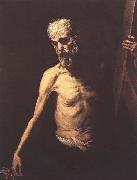Gemälde ID:: 63943
St Andrew
123 x 95 cm Museo del Prado, Madrid Ribera was trained in Valencia, but in about 1616 he moved to Italy, settling in Naples. A clever draftsman and a master of composition, his numerous paintings are more varied than the legends concerning him might lead one to suppose. In his better work the dominant colors, browns and reds, contrast with cruel lighting, which sometimes appears to do violence to the forms. In Ribera highly refined ecxecution and realistic modeling, particularly the marvelous flesh tints of his saints, are combined with a marked preference for dramatic themes, as may be seen in his St Andrew, in the Prado, or better in the painting of the martyrdom of the same saint, now in Budapest. His Crucifixion, in the collegiate church od Osuna, and his Martyrdom of St Bartholomew (1630) in the Prado, are similar in intention and technique. A preference does not imply total exclusion, and there is evidence that Ribera was also a sumptuous colorist. His style evolved from an early preoccupation with 'tenebrist' techniques, through a period of experiment with a silvery light, to a final stage characterized by warm and golden tones. One of his most beautiful paintings is the Holy Family in the Metropolitam Museum of Art in New York. Ribera also practiced engraving and his influence was considerable, both in Italy, where he lived in Naples when it was ruled by Spanish viceroys, and in Spain. Much of his work was intended for Spanish patrons and was an object of admiration as well as a stimulus to Spanish painters. , Artist: RIBERA, Jusepe de , St Andrew , 1601-1650 , Spanish , painting , religious
|
|











